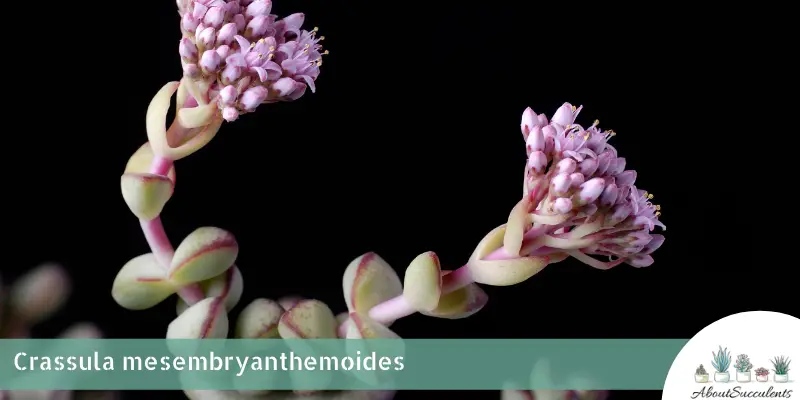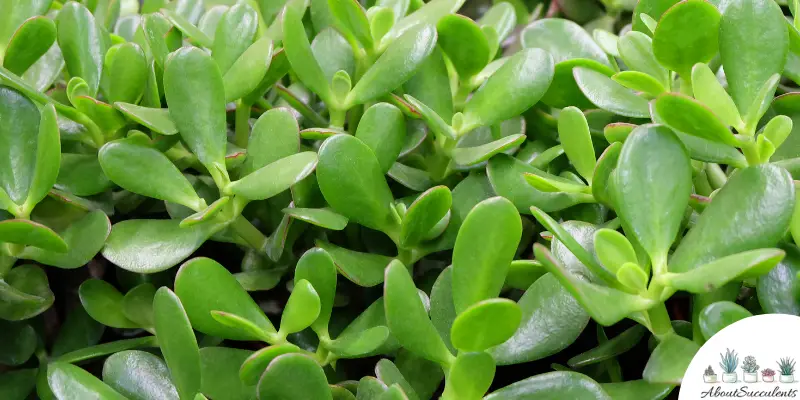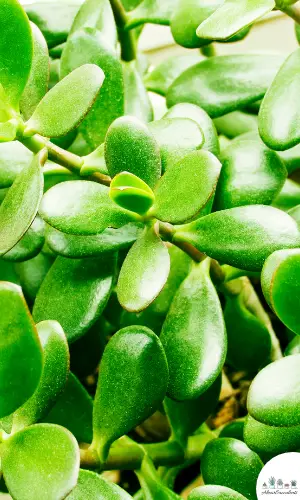
Crassula mesembryanthemoides has a name that might cause frequent mistakes in spelling. Instead, you can refer to it by its nickname “Crassula Moon Glow”. This shrubby-looking succulent challenges the notion of beauty in the eyes of the beholder because plant hobbyists and horticulturists adore it for the bizarre appearance that gives it a somewhat peculiar appeal.
Crassula Moon Glow is easily identified by its banana-shaped, bright-green leaves that are engulfed in finely-textured, white hairs. The fleshy leaves grow in pairs and sit on top of woody stems that are likewise covered in soft hairs. As the stems age, their color changes to reddish-brown.
This is a small succulent and Crassula Moon Glow will only reach a maximum height of 16-inches (40.64cm) and about the same in terms of width. The leaves measure approximately half-an-inch long or slightly over a centimeter.
In the fall and winter months, Crassula mesembryanthemoides will bloom small, bell-shaped, off-white, or cream-colored flowers on the tips of its branches.
Crassula mesembryanthemoides is a member of the Crassulaceae family and is native to the Eastern Cape regions of South Africa, the Karoo, and the Valley Bushveld.
General Information
Also known as: Crassula Moon Glow
Plant Family: Crassulaceae
Origin: Eastern Cape regions of South Africa, the Karoo, and the Valley Bushveld
Height: 16-inches (40.64cm))
Exposure: Partial sunlight for up to 6 hours
Water Needs: Check the soil and make sure it’s 100% dry before giving it a good soaking.
Soil Type: Cactus or a commercial succulent mix with perlite, pumice, coarse sand, and lava rocks for better drainage.
Soil pH: 6.1 to 6.5
How to Grow and Care for Crassula Mesembryanthemoides

It doesn’t matter if you’re a long-time horticulturist or a first-timer. Crassula mesembryanthemoides is a wonderful choice because this charming succulent is easy to grow and care for.
You can plant Crassula Moon Glow in the outdoor garden or have it as an indoor succulent to add life and color to your home.
Keep in mind that this isn’t a cold-hardy succulent. If the temperature in your region drops below 30° F ( -1.1° C), it would be best to plant Crassula mesembryanthemoides in a pot that can be moved indoors.
Sunlight
Crassula Moon Glow prefers partial to full sunlight. As part of your outdoor succulent garden, place Crassula Moon Glow in a location that gets up to 6 hours of partial sunlight every day.
Avoid putting Crassula mesembryanthemoides in locations that are exposed to the full rays of the afternoon sun. If this isn’t possible, make sure Crassula is placed behind taller plants that can give it partial shade.
As an indoor succulent, place Crassula Moon Glow near a window that gets 4 to 6 hours of partial sunlight. If the available locations do not provide enough sunlight, put Crassula under a Grow Light for up to 6 hours daily.
If the succulent doesn’t receive enough sunlight, its leaves will stretch out and wither away. This phenomenon is called etiolation where the leaves appear to be reaching out for sunlight.
Watering

Busy people love succulent plants because they don’t need much care. It can be said that neglect is better than fussing over a succulent. Crassula mesembryanthemoides will be perfectly fine if you don’t water them for over a week.
Before giving the plant water, make sure the soil is 100% dry. Watering the soil while it still carries moisture will lead to root rot.
Checking the soil’s level of dryness is easy. All you have to do is to insert a stick an inch deep into the topsoil. Pull the stick out and if its end feels dry to the touch, prepare the soil for a thorough soaking.
An important tip to remember is to water the soil and not the plant. If you water the plant, its leaves and stems will remain moist for a long time. Water the soil directly and get it drenched.
Pot and Soil
A pot that’s made of unglazed ceramic or terracotta is the best choice for Crassula mesembryanthemoides. These materials help moisture escape from the soil faster than other types of pots. It’s very important that the pot has drainage at the bottom.
The best choice of soil for Crassula Moon Glow is one that has good aeration and water filtering properties. Sandy soil, cactus soil, and a commercially available mix of succulent soil are all good choices.
You can add filtering ingredients such as perlite, pumice, coarse sand, and lava rocks to further improve the soil’s level of drainage.
How to Propagate Crassula Mesembryanthemoides
If you want to add to your collection Crassula mesembryanthemoides, you have 2 methods of propagation to choose from – stem cuttings and seeds.
It might be trickier to propagate from seeds but described the step-by-step process if you have a green thumb.
Method 1: Stem Cuttings
Step 1: Choose a healthy stem and cut it off with a sterilized and sanitized pair of garden shears or a knife.
Step 2: Place the stem cuttings in a clean area to dry out and develop calluses which might take 3 to 4 days.
Step 3: Once the calluses have appeared, plant the stems on well-draining soil.
Step 4: Lightly water the soil and position the pot in an area that gets partial sunlight.
Step 5: If you notice the roots take hold of the soil, only give it water when the soil has completely dried out.
Method 2: Seeds
Step 1: Plant the seeds in well-draining soil.
Step 2: Lightly water the soil.
Step 3: Cover the soil with plastic and position the pot near an area that gets partial sunlight.
Step 4: Wait for the roots to grow out and then water the soil only when it’s 100% dry.
Frequently Asked Questions
Is Crassula Mesembryanthemoides Toxic For Cats And Dogs?
Crassula mesembryanthemoides isn’t on the list of plants that are toxic for cats and dogs that appear on the website of the American Society for the Prevention of Cruelty to Animals (ASPCA).
Why Is My Crassula Mesembryanthemoides Dying?
If your Crassula mesembryanthemoides looks like its dying, the usual suspects are overwatering and pest infestation. You can nurse Crassula back to the green of health if you act right away.
Overwatering
A sure sign of overwatering is discoloration on Crassula Moon Glow’s dark green leaves. Discoloration can appear as yellowish-brown spots on the leaves and stems.
This is a symptom of infection taking place within your plant as the roots have ruptured and turned rotten due to overwatering.
When you see signs of discoloration, remove the infected sections with a sanitized and sterilized knife or garden shears. Remember to sanitize the cutting tool with 70% isopropyl alcohol before you remove another infected section.
Remove the plant from its soil and inspect the other roots. Cut out all infected roots and allow the plant to get dry before replanting in a pot with fresh, new soil.
Pest Infestation
Pests such as mealybugs and aphids love succulent plants for their nutritious sap. Get rid of pests by spraying Crassula Moon Glow with natural neem oil.
Mealybugs produce white, cotton-like substances on the plant’s leaves. Wipe these off with a cotton ball soaked in 70% isopropyl alcohol before they contaminate Crassula Moon Glow.
Yes, Crassula mesembryanthemoides will produce small, bell-shaped flowers that have cream or off-white color in the winter and fall months. The flowers will appear on the edges of the plant’s branches.
Last Updated on June 9, 2022 by Sofia Lara